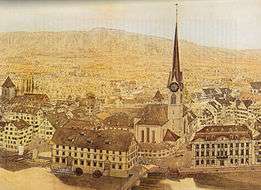Zunfthaus zur Meisen
|
Eastern facade as seen from Limmatquai | |
| Established | 1908 |
|---|---|
| Location | Münsterhof, Zürich |
| Coordinates | 47°22′12″N 8°32′39″E / 47.37000°N 8.54417°ECoordinates: 47°22′12″N 8°32′39″E / 47.37000°N 8.54417°E |
| Architect | David Morf |
| Owner | Zunft zur Meisen |
| Public transit access | Zürich Tram lines 2, 4 and 15 stop Helmhaus at Limmatquai, or Limmat tour boat towards Storchen |
| Website | Official website |
The Zunfthaus zur Meisen is the guild house of the Zunft zur Meisen. It is one of the many historically valuable buildings in the Lindenhof quarter in Zürich, Switzerland, and also houses the porcelain and faience collection of the Swiss National Museum. It is situated at the Münsterhof and the Münsterbrücke Limmat crossing, opposite of the upper Limmatquai respectively the Constaffel, Zimmerleuten, Kämbel and Saffran guild houses.



History
The Zunft zur Meisen
In 1449, the former Zunft zum Winlütten (innkeepers guild) built a house named der Meysen hus.[1] That same year the guild, which was composed of vintners, tavern owners, saddlers and painters, changed their name to reflect the name of the house, Zunft zur Meisen (Meisen guild).[2]
The Zunft zum Winlütten, along with the other medieval Zürich guilds, was founded in 1336, based on a system established by Rudolf Brun, Zurich's first independent mayor. Although the guilds represented various craft associations, they were also economic, political, social and even military organizations that participated in the wars of the medieval city republic as independent military units. They also constituted the councilors of the elitary council of the medieval city republic of Zürich, until the French revolutionary troops terminated the guild regime, and the Old Swiss Confederacy collapsed in spring 1798.
The Zürich guilds, except for the women members of the Fraumünster society who only participate as guests of the Constaffel,[3] still celebrate Sechseläuten.
Building of the Zunft
In 1752, construction of a new guild house was begun, and the widows of two stonemasons caused a stir by submitting a lower bid than their male counterparts. The two women were given the contract.[4] The building is located on the Limmat river's left shore, in immediate neighborhood of the Fraumünster abbey at the Münsterhof plaza.
The building originally housed an observatory, the Urania Sternwarte, on its roof. In 1759, the astronomical commission used this telescope to define the Culminatio solis, thus determining the exact location of the city of Zürich on the globe.
In the 19th century, Gottfried Keller and Ferdinand Hodler were among the most famous guests of the former Café zur Meisen. In the 20th century, Gustaf V of Sweden, Winston Churchill, Elizabeth II of the United Kingdom and Jimmy Carter were all visitors. The building is still a restaurant of the higher price class.[5]
Architecture
The former Zunft zum Winlütten had its guild house at Marktgasse. In 1757, a Rococo palace in the French style – with a cour d'honneur and elegant puddling doors – was built by the architect, David Morf (1700–1773). The stone for the building was Bollinger sandstone from the quarries on Obersee lake shore.[6] Particular attention was given to the interior of the building; the ceiling and wall paintings are by Johann Balthasar Bullinger, the masonry heaters by Leonhard Locher and Hans Jakob Hofmann, and the elaborate stucco ceilings by the Tyrolean master Johann Schuler.[5]
Porcelain and Faience collections
The guild house is one of the seven sites of the Swiss National Museum and houses its porcelain and faience collection. The permanent exhibition gives an overview of the Swiss porcelain and faience factories of the 18th century, and the development of forms and patterns of dishware and miniatures. One of the focuses are the products of the Porzellanmanufaktur Schooren (1763–1790) in Kilchberg. Changing exhibitions further explain the history and the work of well-known porcelain manufacturers and other cultural and historical issues in Zurich, such as the anniversary exhibition Frauen, Zunft und Männerwelt – 250 Jahre Zunfthaus zur Meisen (Women, Men's Guild and the world - 250 years Guild house Meisen).[4][7]
Cultural heritage of national importance
The Meisen building and its collection is listed in the Swiss inventory of cultural property of national and regional significance as a Class A object of national importance.[8]
Literature
- Markus Brühlmeier, Beat Frei: Das Zürcher Zunftwesen. Verlag Neue Zürcher Zeitung, Zürich 2005. ISBN 3-03823-171-1.
References
- ↑ "B VI 304 (fol. 4) Bürgermeister, Rat und Bürger von Zürich verkaufen dem Zunftmeister und der Zunft der Weinleute (Meisen) für 84 Gulden e... (1373.08.01)" (in German). Staatsarchiv des Kantons Zürich. Retrieved 2015-09-11.
- ↑ "Zunft zur Meisen" (in German). zunftzurmeisen.com. Retrieved 2015-09-11.
- ↑ Tina Huber (2014-11-06). "Manche Witze sind unter der Gürtellinie" (in German). Tages-Anzeiger. Retrieved 2014-11-06.
- 1 2 "Frauen, Zunft und Männerwelt - 250 Jahre Zunfthaus zur Meisen: 29.8.-25.11.08" (in German). -zuerich.ch. Retrieved 2015-09-11.
- 1 2 "Zunfthaus zur Meisen: Geschichte" (in German). zunfthaus-zur-meisen.ch. Retrieved 2015-09-11.
- ↑ "Baumaterial für Zürichs Prunkfassaden" (in German). nzz.ch. 2004-10-18. Retrieved 2015-09-15.
- ↑ Swiss National Museum: Changing exhibitions Archived October 27, 2007, at the Wayback Machine. (German)
- ↑ "A-Objekte KGS-Inventar" (PDF). Schweizerische Eidgenossenschaft, Amt für Bevölkerungsschutz. 2015-01-01. Retrieved 2015-09-13.
External links
| Wikimedia Commons has media related to Zunfthaus zur Meisen. |
- Official website
- Landesmuseum (German)